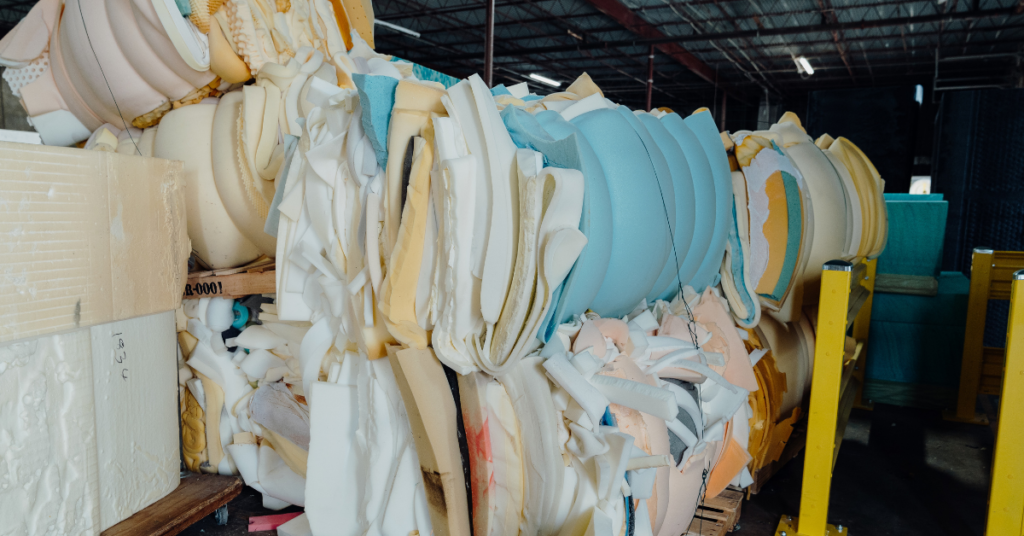Did you know that raw materials account for about 80% of the carbon footprint? This is why recycling raw materials can have a huge impact on your environmental impact. Expandable Polystyrene (EPS), Polyurethane (PU), and Polyethylene (PE) are three raw materials that are often used in manufacturing. EPS is most commonly found in packaging, PU is found in insulation, and PE is found everywhere from plastic bags to car bumpers. Recycling these raw materials has many benefits! Read this blog post to learn more about how you can recycle these raw materials at home or work!
Recycling EPS, PU and PE is important because it can save carbon emissions, energy usage, water use and more.
- Carbon emission savings: recycling raw materials like these reduces carbon emission by up to 80%.
- Energy usage reduction: recycling less material means that you also need less energy for manufacturing processes. This makes the process cheaper but also helps reduce your carbon footprint!
- Water usage reduction: recycled plastic requires much less water than when making new products out of virgin resources. Another plus point to help prevent climate change! We all play a part in protecting our environment so just think what small changes you could make today?
Plastic recycling is the reprocessing of plastic waste into new and useful product materials. Plastic recycling is a value-adding process to raw plastic waste, turning discarded plastics into useful products that can be sold and manufactured back into the capital cycle.
Plastics have a negative connotation because of the way they are often disposed of. When most people think of plastic, they think about the negative environmental impact it has when it is not recycled. This could not be further from the truth! Plastic recycling is a process that can have a huge positive environmental impact if done correctly. Let’s take a closer look at some benefits of recycling plastic.
One reason why recycling plastic is so important is that it takes less energy to recycle. Plastic recycling reduces reliance on natural resources by keeping materials in use rather than taking them out of circulation for disposal or energy recovery.
Avoiding carbon emissions through reduced extraction of raw materials used to produce virgin feedstock saves more greenhouse gas than it emits during production and processing stages associated with recycled feedstocks because some CO is captured at source when new material replaces scrap derived from scrapped equipment or structures (e.g., buildings). A global life-cycle assessment study reported close agreement between US EPA estimates based on mixed municipal solid waste (MSW) streams vs actual emissions when the use of recycled feedstock avoided emissions from virgin plastics production.
Recycling Expanded Polystyrene (EPS):
Expanded Polystyrene (EPS) is recyclable and is being recycled by businesses and consumers across the world. The EPS industry developed collection infrastructures to support global recycling efforts. EPS can be recycled into a variety of new products. The raw material is often used in manufacturing. It is most commonly found in packaging, and it has a huge environmental impact. EPS takes up a lot of space in landfills, and it can take centuries to decompose! That’s why recycling EPS is so important! There are many ways to recycle EPS, and you can do it at home or work.
One way to recycle EPS is to use it as insulation. Insulation helps keep your house warm in the winter and cool in the summer. You can buy insulation made from recycled EPS at your local hardware store. Another way to recycle EPS is to use it for building projects. You can use recycled EPS to make walls, roofs, and even furniture!
Recycling Polyurethane (PU):
As a highly recyclable substance, polyurethane plays a major role in this effort. Polyurethane is recycled in one of two ways: either mechanically, in which it’s reused in its polymer form, or chemically, in which it’s broken back down into its chemical components., in which is broken down into raw materials. In either case, it can be reused to form a new base for polyurethane products or other plastics that have been made from raw materials derived from petroleum sources.
Polyurethane is often recycled to produce new products, such as insulation, car parts, and furniture. Recycling polyurethane helps reduce our reliance on natural resources, and it also reduces greenhouse gas emissions.
Recycling Polyethylene (PE):
Polyethylene (PE) is widely recycled today due in large part to the growth of curbside recycling programs and drop-off centers at grocery stores and retail outlets across North America. Polyethylene can actually be recycled back into itself with no loss of quality or strength through what’s known as an energy loop, meaning bottles are collected from consumers after use, sorted by resin type if necessary, melted down, and extruded once again as high-density PE packaging – feeding right back into manufacturing applications.
Polyethylene can be recycled to produce a number of items, including carpets and even new bottles. It can also be used to make a variety of shipping pallets that are both strong and durable.
Polyethylene is the most common form of plastic waste being recycled today due largely in part to its availability for recycling at local collection centers. Most supermarkets have dedicated bins for collecting PE materials which makes it easier than ever before to get involved with your community’s recycling program!
Benefits of plastics over other raw materials:
The benefits of using plastics instead of other raw materials are vast. Not only do plastics help reduce our reliance on natural resources, but they also play an important role in reducing greenhouse gas emissions. When it comes to recycling, plastics are some of the easiest materials to recycle! So please make sure you recycle your EPS, PU and PE products when you’re finished with them – it’s good for the environment!
Recycling these raw materials has many benefits! It helps reduce your carbon footprint, saves space in landfills, and helps preserve our natural resources. If everyone recycled these raw materials, we could make a huge difference for the environment! So what are you waiting for? Start recycling EPS, PU, and PE today!



Thank you for explaining to us that EPS is recycled to use as insulation since it’s quite beneficial when it comes to keeping our house warm during winter and cool in the summer. It’s winter now, and I’m planning to improve the insulation of our home to ensure we’re warm even during the coldest day of the year. I’ll keep this in mind while I look for a contractor to get in touch with for EPS insulation soon.
One solution that I would like to highlight is the use of recycled plastics. Companies like Raw tech trade are doing their part by providing a marketplace for buying and selling recycled plastic materials. By supporting this marketplace, we can help promote the use of recycled plastics and reduce our reliance on virgin plastics.